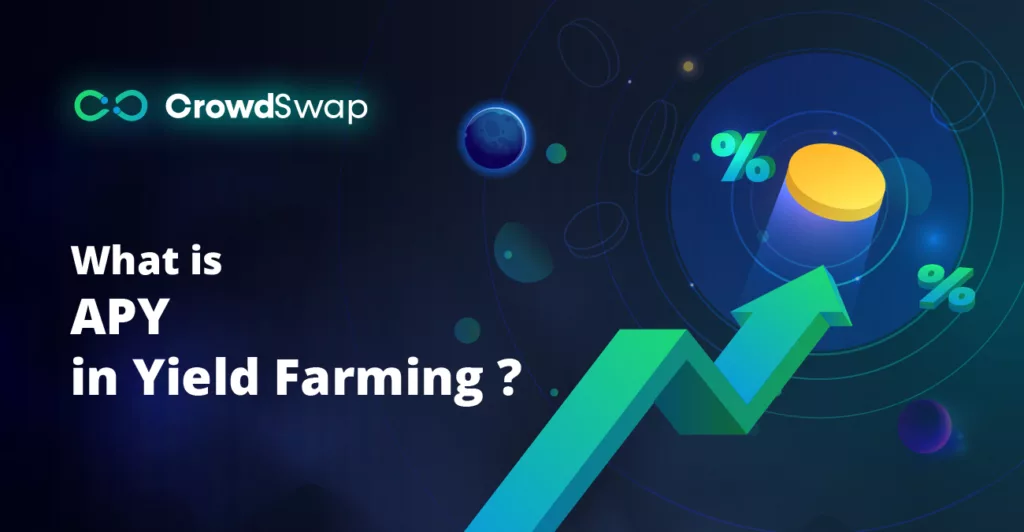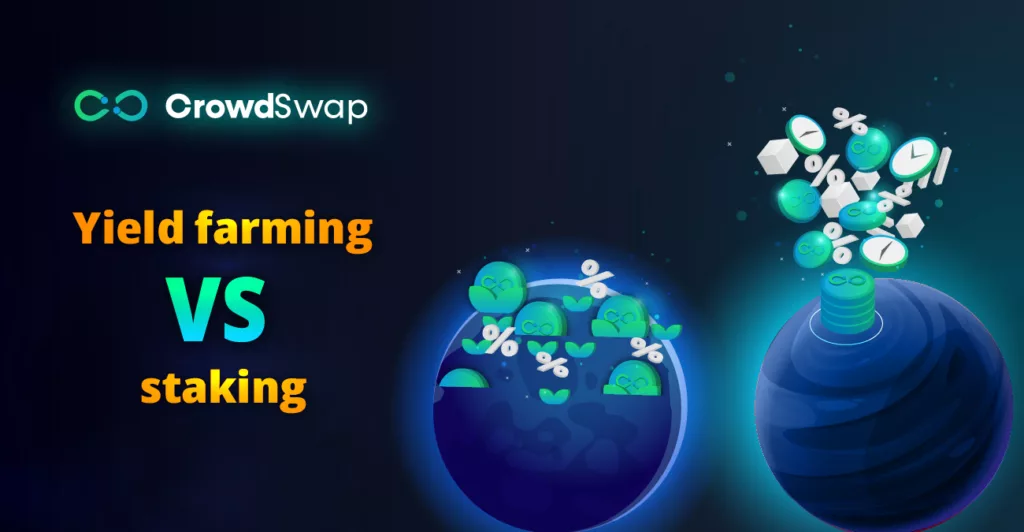Yield farming is like planting a seed and watching it grow into a money tree. It is one of the recent and popular ways that users can use to make profits as the world of DeFi continues to develop and provide new opportunities for users. Crypto investors can earn attractive returns from their tokens with those opportunities. The number of yield farmers continues to grow, and so does DeFi, which also improves. Using smart contracts ensures high levels of transparency as users pool their tokens to earn a return from the investment. In this article, we’ll define farming crypto and explain how it works. You can learn what yield farming is and how to select the best opportunities to invest and get rewards. We’ll also look at why it is important and go over tips to help you with yield farming in your crypto investment journey.
What is yield farming?
In yield farming, crypto users lend crypto to get returns through interest. Similar to the interest earned on loans from banks, yield farming also enables the yield farmers to earn fees and interest from their tokens. Only in yield farming, interest and fees come as virtual tokens. DeFi yield farming also occurs in a decentralized environment, which lacks an intermediary. To understand yield farming, the best answer is that The ability to earn interest works as an incentive for crypto users who have tokens to add to the liquidity pool. A user can continue earning high-value tokens as crypto markets remain stable.
About Yield Farming
Yield farming is a trend in cryptocurrency that has sparked new interest in investing and trading cryptocurrency. It is an innovative way to earn rewards on cryptocurrencies by stacking them in a DeFi yield farming platform or providing liquidity to lending and trading protocols.
It has become popular among investors because it offers a high reward-to-risk ratio, often with very low transaction costs and the potential to earn rewards without any risks associated with trading. It uses a decentralized finance (DeFi) platform that provides access to financial services, such as borrowing, lending, and trading, without needing third-party intermediaries. The DeFi platform rewards participants for providing liquidity to the network.
The rewards earned from it depend on the risks taken. Understanding the risks and rewards of each protocol before investing in yield farming crypto is essential. Most DeFi protocols offer rewards through interest earned on deposited funds or tokens.
It also requires investors to assess the downside risks associated with each protocol. This includes the risk of losing funds due to hacks and scams or earning less-than-expected returns due to competition from other investors.
Read more about: What is DeFi? All you need to know about decentralized finance – CrowdSwap
How does yield farming work?
To get started with yield farming. Select two types of cryptocurrency, say, Token A and Token B, like picking the perfect companions for your quest. These tokens will be paired in a liquidity pool on a decentralized platform, much like forming a dynamic duo.
Now, you toss these paired tokens into the liquidity pool like two daring comrades entering a mystical cave. This is where the magic begins. You’re not just holding these tokens; you’ve transformed them into a liquidity provider, helping other traders make their moves in the crypto realm.
As these tokens sit in the pool, traders come and go, like knights seeking treasures. They exchange Token A for Token B, or vice versa, and each time they do, you earn a piece of the action. It’s like a piece of gold for every transaction, filling your treasure chest.
But remember, while this adventure can be rewarding, it’s not without its twists. The value of Token A and Token B might change, affecting your earnings. This is the tricky part known as impermanent loss – think of it as a dragon you must be cautious of in your crypto journey.
Also, keep an eye on the best yield farming platform. Ensure it’s reputable and secure, like a trustworthy guide for your quest.
So, yield farming crypto is like becoming a crypto innkeeper, providing liquidity for traders and earning rewards as they pass through. Remember, in this enchanted forest of DeFi yield farming, every step can bring you closer to treasures, but it’s wise to have your sword and shield ready for the unexpected twists!
Read more about What is a liquidity pool in DeFi.
Why is yield farming important?
After answering the question of yield farming, you should know why Yield farming is important, as it is one way to open DeFi to crypto investors. Users increase the value of their tokens as they contribute to the growth of Decentralized Finance markets. As a crypto investor, one can earn an annual percentage yield from their token investment. This makes it possible to increase the returns from an initial token investment.
CrowdSwap’s yield farming opportunities
At CrowdSwap, we take great pride in offering our valued users carefully curated yield farming opportunities. We aim to minimize risks and ensure the safest possible investment experience while maximizing the potential rewards.
As market-leading and one of the best yield farming platforms, CrowdSwap offers opportunities for lenders involved in yield farming.CrowdSwap can help to identify the token pairs with the highest potential returns.
One standout feature that sets us apart is our commitment to using our native token, CROWD, to create liquidity pools. These pools are the backbone of our swap and cross-chain services, adding intrinsic value to CROWD. Now, why does this matter?
Here’s the deal: The more you utilize CROWD in our services, the more valuable it becomes. Valid, this can affect its price and the rewards.
Tips and reminders to yield farming
As you plan to start to yield farming, here are a few tips and reminders:
- To earn from yield farming, users need a suitable platform that helps them explore existing investment opportunities. CrowdSwap is one of the best yield farming platforms that provides users the tools to start and grow in yield farming.
- The annual percentage yield is an estimated value of returns an investor gains from their token investment in liquidity pools.
- Risks such as hacker attacks and crypto volatility affect the returns from yield farming. Knowing how the risks might affect users’ token investment goes a long way in successful yield farming.
DeFi yield farming allows users to grow their crypto investments by earning from a token investment into liquidity pools. The rate of return depends on forces in the DeFi space. It also has to do with the participation of other users in the process, which affects the experience of all users.
To get the best experience, start with a reliable and secure platform like CrowdSwapd—a decentralized exchange. It’s one of the best yield farming platforms where You can let the app handle all the complex operations as you watch your investment grow.
Benefits of yield farming
The benefits are numerous and often outweigh the risks associated with the activity. For starters, it yields higher returns than traditional savings and investment methods. It also gives users greater control over their investments because the limitations of conventional forms of investing do not bind them. It also offers greater liquidity, meaning users can earn rewards faster.
In addition to these primary benefits, it also offers diverse opportunities for investors.
For example, investors can provide liquidity to various decentralized finance protocols to maximize yields. Yield farmers can also diversify their investments by delivering liquidity across multiple DeFi protocols to minimize the risk of losses. Many DeFi yield farming users also enjoy the
perks of yield farming, such as staking pools and low gas fees.
Whether you’re an experienced investor or a crypto newbie, it can be a great way to generate high returns on your cryptocurrency investments. With the right strategies, yield farmers can potentially generate significantly higher returns than those from traditional investments.
Although it has risks and uncertainties, the benefits can make it a worthwhile investment for any crypto enthusiast.
Read more about How to Invest in DeFi – CrowdSwap.
The Risks of Yield Farming
Yield farming is an increasingly popular trend in cryptocurrency, allowing users to earn rewards from the blockchain and its underlying technologies. However, like any financial transaction, it comes with some risk. This blog will discuss the critical risks and provide tips for protecting yourself.
Volatility:
It involves high levels of volatility, which can cause sudden changes in token prices. This can be especially risky when you enter into leveraged positions, as it could cause substantial losses if the token price unexpectedly falls. To reduce your risk, diversification is critical. Spread your investments across multiple tokens to balance out potential losses.
Technical Risks:
It requires sophisticated knowledge of blockchain technology and smart contracts. You could be exposed to technical errors or hacker attacks if you don’t understand what you are doing. Before entering a yield farming venture, ensure you know the technical aspects of smart contracts to choose the best yield farming platform.
Liquidity Risk:
Many exchanges and tokens used in yield farming must be more balanced and easier to exit. This means you could be stuck in these tokens for lengthy periods if you need to leave quickly. Before investing, research the liquidity of the tokens and try to diversify your investments across multiple exchanges.
Fraud:
Unfortunately, yield farming crypto is especially vulnerable to fraud due to its unregulated nature. Hackers and scammers easily victimize users because they don’t follow any regulations or rules. To protect yourself, only invest in reputable tokens and platforms and constantly research before committing funds.
By understanding the risks, you can better protect yourself from potential losses and scams. As with any investment, making informed decisions and continuously diversifying your portfolio is essential.
Read more about: 10 Things to Avoid While Using DeFi Services – CrowdSwap.
Why should we care about yield farming?
While yield farming crypto can offer attractive returns, it’s necessary to understand that there are risks associated with this strategy.
The volatile nature of yield farming, flash loan attacking, and impermanent loss are all risks that can lead to significantly reduced returns or even a complete loss of capital.
This is why it’s essential to understand the risks of and assess the potential of your investments against these risks before getting involved in the process. Flash loan attacking refers to exploiting the loans to rapidly exploit profits within the same block. Similar to margin trading, this can result in high profits but also high losses in case of misjudgment.
Impermanent loss (IL) is a risk caused by the differences between the prices of what you have staked and the price of what you receive. This requires constant and vigilant monitoring to prevent any losses.
Before investing, knowing the risks associated with any project is important. It’s essential to ensure you’re investing in reputable platforms with a strong track record and detailed policies outlining how the platform will handle risks during sudden market downturns and other unforeseen events.
In short, it’s essential to take the time to understand the risks and do your due diligence when considering investing in these projects. By understanding the risks and purposefully navigating these markets, investors can take advantage of the potential for high-yield returns without subjecting themselves to the same risks as those unaware.
What Is APY in Yield Farming?

Generally, yield farming occurs in the decentralized finance (DeFi) market, a collection of financial services and products powered by blockchain technology. Its rewards are determined by the annual percentage yield (APY), representing the returns traders and investors earn throughout a given investment period.
The APY in yield farming is determined by the yield earned by the user throughout the investment period. Generally, the higher the yield, the higher the APY. However, it is a high-risk investment, and the APY can go up or down depending on the market conditions. This means that the rewards received by farmers will vary from period to period. Additionally, since it is built on DeFi protocols, yield farmers can face the risk of contracts needing to be executed properly.
The APY determines Yield farming rewards, which consider factors such as the amount of capital being held in the locked-up token, the length of the investment period, the token’s return rate, and the implied returns associated with providing liquidity.
When yield farming, users are expected to provide liquidity to a decentralized exchange in exchange for a reward. The rewards come in the form of either the native token of the protocol (e.g., a BNB) or one of the tokens listed on the exchange (e.g., USDT). The APY is calculated by considering the fees associated with providing liquidity. The rewards received for doing so, and the amount of time the liquidity is earned.
Read more: What Is APY in Crypto? – CrowdSwap
Yield farming vs. staking

Yield farming and staking are both budding financial concepts in cryptocurrency. With the explosive growth in the DeFi (Decentralized Finance) sector over the past year, yield farming and staking have become popular ways to generate passive income. While the concepts are related, there are some essential differences between them.
It refers to financial activities that involve leveraging multiple DeFi protocols to optimize income from token rewards. With yield farming,
Users can farm various tokens by providing capital, liquidity, and governance to DeFi yield farming protocols. These tokens can then be exchanged for other tokens or fiat currencies.
It’s a highly technical process requiring understanding of blockchain technology and smart contracts. The benefit is that it can produce higher returns than traditional staking. However, the risks associated with it are also much higher.
On the other hand, staking can be considered a traditional form of passive income. It’s a process by which users `lock up ” a specific amount to a particular coin in exchange for a steady income stream. The reward amount is proportional to the amount of stacked coins, so it bears some similarity to standard banking systems. Users are rewarded for helping robust the network by voting on proposals and maintaining a certain level of liquidity. Staking is less passive than yield farming, as it requires active participation in the network for users to receive rewards. However, the returns are generally higher than those generated through traditional methods.
Thus, yield farming and staking are two ways to generate passive income from cryptocurrencies. While both involve different risks and rewards, each has its unique advantages. It is more demanding and can produce high returns but carries a specific risk. Staking, while more passive, creates more stable returns but doesn’t offer as much upside. It’s up to users to decide which approach is better for them, depending on the specific situation.
Read more about staking-vs-yield-farming
Yield farming calculator
In cryptocurrency, yield farming is a prominent strategy for generating passive income. To determine the amount of revenue you can earn by yield farming, you’ll need a calculator that can provide you with a precise estimate.
A calculator is a tool that can help you quickly determine the monetary benefits of your efforts. It will also provide you with essential information about the various fees and rewards associated with your operations. The calculator includes input fields for the type of tokens you’ll be using, the time frame of your efforts, and your desired returns. Once you fill out the necessary fields, the calculator will accurately estimate your approximate returns over the specified time frame.
Using a calculator lets you quickly calculate the estimated returns of your farming operations. By examining the various fees and rewards associated with yield farming, you can determine the best strategies for earning maximum passive income. This calculator provides an excellent opportunity to make informed decisions and maximize earnings.
A calculator is an excellent tool for anyone looking to maximize their passive income through it. Its simple interface and accurate estimates can help you determine the potential gains from your efforts and help you make the best decisions for your operations.
Yield farming rates
To maximize yield farming returns. Considering the rates of different liquidity pools before depositing is crucial. Rates will vary greatly depending on the types of tokens in the pool, the amount of total liquidity in the pool, and the pooling protocol used. Typically, the higher the total liquidity of the pool, the higher the rate of the pool. Understanding the liquidity pool’s underlying protocols is essential to get the most accurate rate information, understanding the liquidity pool’s underlying protocols is essential. One can find the highest yield rate with the amount of liquidity requested with the correct protocol chosen. That said, it is still important to shop around and review various pools for any special incentives that can impact the rate of return.
It is becoming increasingly popular due to its potential for earning passive income. By taking the time to understand the rates of different pools, a savvy investor can maximize returns. One can make the most out of cryptocurrency investments with a greater understanding of yield farming.
Best yield farming strategy
Yield farming can significantly maximize your returns if done correctly. It uses liquidity mining, staking, and other methods to generate income in decentralized finance (DeFi) protocols. The strategy offers the opportunity to create passive income and capitalize on the rapidly expanding DeFi yield farming space.
One of the most popular strategies is providing liquidity to liquidity pools. In this strategy, users deposit tokens into a liquidity pool and are rewarded with a portion of the trading fees generated from the pool. Generally, liquidity pools trade two different tokens, which means users receive rewards in both tokens. This strategy is relatively low risk and requires minimal monitoring.
Another popular strategy is providing liquidity to tokenized assets. Users can get rewards with these tokens regularly. These rewards can then be reinvested into other strategies, allowing users to capitalize on the potential gains of the DeFi space without having to purchase the underlying assets.
For example, Imagine you have a significant amount of Ethereum (ETH) and are interested in earning passive income without selling your ETH holdings.
One way to do this is to provide liquidity in a liquidity pool that involves ETH and a stablecoin like USDC in a decentralized exchange platform like CrowdSwap.
You deposit a certain amount of ETH and an equivalent value of USDC into the ETH-USD liquidity pool on CrowdSwap.
In return for providing liquidity, you receive liquidity pool tokens (let’s call them ETH-USDC LP tokens) that represent your share of the pool.
As traders use CrowdSwap to swap ETH for USDC and vice versa, they pay a small fee for each transaction, and These fees are added to the liquidity pool.
Over time, you earn some of these fees through additional ETH and USDC. These rewards are directly proportional to the amount of liquidity you’ve provided to the pool.
You can regularly harvest and reinvest these rewards in other yield farming crypto strategies or simply hold them.
Finally, staking is another popular strategy. By locking in a certain amount of tokens into a DeFi protocol, users can be rewarded with a share of the fees generated. This is a relatively low-risk strategy; rewards are generally paid out weekly as DeFi protocols and projects increase in popularity and generate more fees.
Trade Effortlessly
Ready to dive deeper? Our crypto exchange is simple and user-friendly, making trading a breeze
Conclusion
Yield farming is a new form of earning passive income in cryptocurrency. It involves staking or lending cryptocurrencies in order to earn rewards. It attracts investors because it can generate returns without needing active trading.
Overall, it offers the opportunity to create passive income in the rapidly expanding DeFi space. It is a relatively new sector of the crypto market, and it is vital to recognize that it is a high-risk investment. The rewards received can fluctuate depending on the market conditions. As always, we urge users to research and understand the risks associated with yield farming and do our best to give them valuable material to help them reach this understanding.
FAQ
Why do investors engage in yield farming?
One of the critical benefits of yield farming is that it allows investors to earn a return on their assets without selling them. This can be particularly attractive for investors who believe that the value of their assets will increase in the future.
What are the risks of yield farming?
The volatile nature of yield farming, flash loan attacking, and impermanent loss are all risks of yield farming that can lead to significantly reduced returns or even a complete loss of capital.
What is the best strategy for yield farming?
If the yield farmer establishes that their tolerance to risk is low, the best strategy for them will be staking or lending established coins, such as Ethereum (ETH). This will mean lower risk but lower reward.
Is yield farming passive?
Yield farming can be a lucratiUsers can expect their staking rewards to increase to earn passive income, although it isn’t risk-free.













